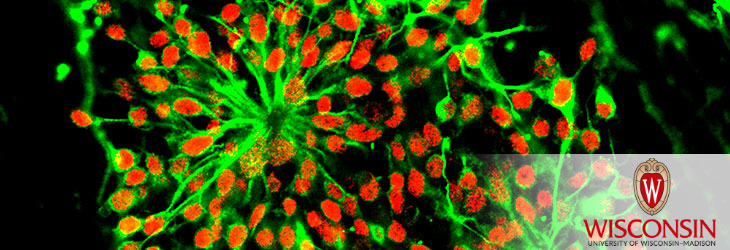Pluripotent Stem Cells

Master Human Stem Cell Lines for Gene Expression and Knockdown
WARF: P07393US
Inventors: Su-Chun Zhang, Zhong-wei Du
The Wisconsin Alumni Research Foundation (WARF) is seeking commercial partners interested in developing a method for stable gene modification in human embryonic stem cells.
Overview
Human embryonic stem cells (hESCs) are a useful tool for unveiling the cellular and molecular mysteries of human development. Directed differentiation of hESCs could revolutionize pharmaceutical screening and regenerative medicine. But hESCs are difficult to genetically modify, and technical challenges have proven a major roadblock.
The Invention
UW–Madison researchers have developed a method for inserting transgenes (heterologous gene sequences) into specific ‘hot spots’ in the hESC genome where stable and high gene expression may occur.
Insertion is achieved via the Cre-Lox process—a type of site-specific recombination that has allowed researchers to manipulate a variety of genetic modifications to control transgene expression, delete undesired DNA sequences and modify chromosomes.
The method can be used to create ‘master’ hESC lines that serve as templates for inserting any gene of interest. Once a master hESC line is in place, establishing new transgenic lines becomes a basic laboratory routine.
Insertion is achieved via the Cre-Lox process—a type of site-specific recombination that has allowed researchers to manipulate a variety of genetic modifications to control transgene expression, delete undesired DNA sequences and modify chromosomes.
The method can be used to create ‘master’ hESC lines that serve as templates for inserting any gene of interest. Once a master hESC line is in place, establishing new transgenic lines becomes a basic laboratory routine.
Applications
- Genetically modifying hESCs
- Creating master hESC lines
Key Benefits
- No comparable method is available.
- Master hESC lines can revolutionize directed differentiation, discovery of novel gene function, drug/toxicological screening and cell therapy.
Stage of Development
The researchers have used a master line to force differentiation to trophoblasts, endothelial cells, cardiomyocytes and neural cells.
Additional Information
For More Information About the Inventors
Related Technologies
Tech Fields
For current licensing status, please contact Andy DeTienne at [javascript protected email address] or 608-960-9857